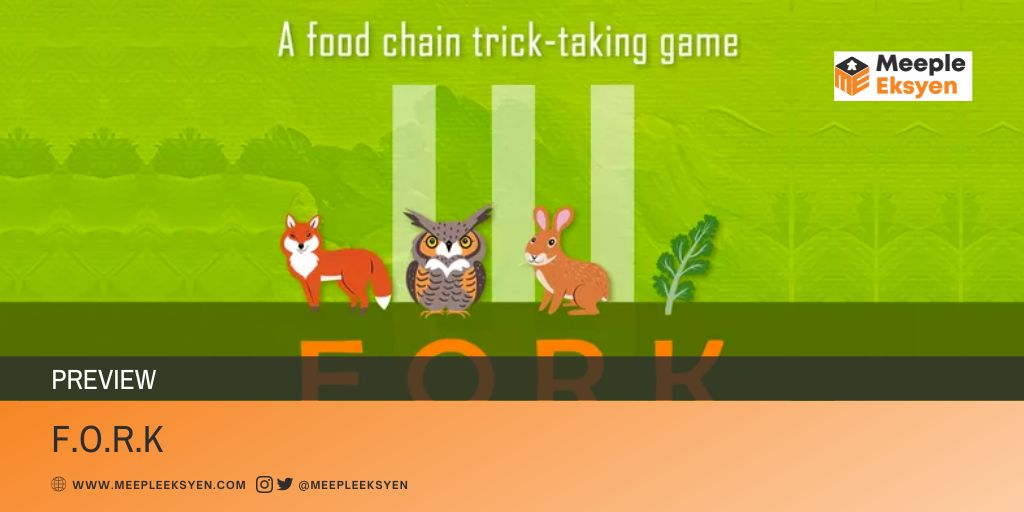Try searching ‘Fork’ in Board Game Geek. I don’t know for what reason, but it has the least entries compared to its cutlery siblings. Nothing’s wrong with it, though. Ta-Te Wu was playing cleverly with words and acronym, I must give him that after reading about his upcoming game, Fork. It was smart. Besides depicting the multitasker silverware that accompanies the spoon and knife, he intends the title as an abbreviation of Fox, Owl, Rabbit, and Kale. Very thoughtful — the connection from both meanings is subtle, but a piece of the entry on Board Game Geek (BGG) signals what this game is about.
The goal of the game is to capture animals or kale in the food chain.
Description from the designer on BGG
A short disclaimer before you read my board game analysis
As an avid euro gamer and hardcore Legend of the Five Rings (L5R) LCG player, my reviews may reflect a preference for these styles, and I may not cover solo games/variants extensively. Please note that my personal remarks are based on my gaming experiences, and I aim to provide honest insights within the scope of my preferences.
Starting the bottom of a food web trophic structure from kale is, pretty much, on the ball. After all, they all start with plants, the producers. It is debatable, though, whether this chain length should really stop at the fox. The foxes are mostly omnivorous, yes. But I mean, owl is deemed as an apex predator, and should perch comfortably on the top. Some may argue that, based on the availability and season, foxes also hunt for the owlets to feed their cubs. Seldom, yet it’s true. Mother Nature indicates that these furies Vulpes rarely live off birds. This topic is open for debate, but we will not dwell too much on it.
Disclaimer: We had the preview copy for this review, and it was not the final version. There might be possible changes and alteration from the publisher regarding the components, printing and build quality, rules and concepts in the official released product.
Fork implements a trick-taking mechanic to the table. I guess it’s becoming more popular these days, thanks to The Crew that got published in 2019 and won the renowned Deutscher Spielepreis. Trick-taking games then flourish even more. They differ vastly forward, for example, while The Crew took a more cooperative and isolated way to play, Ta-Te Wu favours the interaction and competitive nature of the food chains. There is one video on YouTube that may help you to understand how we play Fork.
Fork — how well the food chain dwell
Fork is truly a trick-taking game. The game swathes the mechanic in a sense that still catches a glimpse of the thematic feel. We don’t call ‘suit’ a ‘suit.’ Instead, these become a determined range of landscapes — players can still distinguish them effortlessly through the colours and, for the colour blinds, the icons. Of course, the core trick-taking rules still take place.
One distinctive feature, if not peculiar, is the way to determine the lead suit. Instead of the active player directly playing one card and others follow the suit, he/she needs to decide which Terrain this round will be played. Afterwards, all cards are played face down in turn order. Except for kales. As the bottom of the food chain pyramid, players reveal these producers when they intend to play the kale.
The hidden information when playing a card leaves us in the dark, as the only information available is when one plays a kale card. It happens, at least only in the early game. With no other cards visible, my decision was solely to get rid of my most mediocre card during my first turn. Mostly, those were the lowest rabbits possible. I do understand that by feeding the rabbits, I voluntarily gave 1-3 points for free to the opponent. A reasonable cost to gather information.
Those next few turns were more manageable. Since more cards were revealed through gameplay, Fork became more decisive and no more arbitrary. Each resolution carried more meaning. I did not speculate blindly, which is another way to imply, “I am no more gambling,” as it now required me to make some educated guesses. Regardless, Fork is still a game of conjectures. These surmises are practically common in a trick-taking game, where numerous surprises happen and catch me off guard. That’s the beauty of this particular game. Fork shares the same charmer, which would be an entertaining amusement for the trick-takers.
Survival of the fittest, it is, where the stronger eats the weaker, and it was depicted perfectly in the trick. The fox, as the apex predator, hunts for the owl. Meanwhile, the owl stalks the unaware rabbit that nourishes on the kale. The strongest of the trick goes hunting first, and taking the appropriate food. It would be displayed and counted at the end of the game for points. With this in mind, winning the trick actually rewards us the turn initiative to predate the prey for that turn — which should be one level below that particular animal card we just played (except for Fox), if any. Otherwise, we’d starve during that round.
In the end, winning a trick at Fork “only” awarded me a head start to pick a prey. It felt underwhelming at first, to be honest. Yet, the turn order demonstrates to be indispensable in the game course. It definitely bestows satiated belly, and points as well. The possibility to deny my opposition some points was another unerring fact, indeed. But on the other hand, it created a tiny yet probable cleft for their preys, if any, to escape, which meant points for the other adversary. Was it a necessary evil to balance the game? I think it was.
This mechanic indisputably created an opportunity to bag points from the kale cards. The latter one was notoriously hard to score, in the point-of-view of the in-hand’s possessor.
Kale and the set-collection mechanic
Kale is the pariah, so to speak, in this game. Obviously, it sits at the bottom tier of the food chain, without any prey under. It is nonetheless the most crucial components, as producers become the starting point for this natural pecking order. Scoring kale was rather difficult, though. But only if we were the one who play it from hands. I needed to play it face-up, no protection or concealment. The rabbits might sneak and snatch it, showcasing it in their scoring afterwards. It was a high risk, yet the reward felt underwhelming. I think it would be better if the points awarded from collecting kales increased a bit, aligning the benefit with the menace of playing it.
To deter the risk, I usually played kales only when I became the last player to play in a trick. The risk was still there, yet lower. Revealing a kale card when I am not the last player in the row creates an opportunity for the next player to get tempted and play a rabbit card, and thus, grab my kale. I loved the set-collection mechanic implemented in this part. It went pretty well with the aforementioned higher risk presented by kales.
Optimal player count
It was the designer’s intention to create a trick-taking game from two players and more. Be as it may, it was a Herculean task, creating a one-stop game that cater optimally in all player counts. The two-player variant was not my favourite. Despite Ta-Te’s work to tinker with the rules, I still would recommend playing Fork with up to three player count. The magic numbers are 3-5, nevertheless. In a six-player game, there are two teams competing for the food. It generates a new way and strategy to play the game.
Verdict
My interaction with Ta-Te’s games so far revolves around his trick-taking games. Let’s not forget his successful Macaron Kickstarter project, for example. Fork carries the same main mechanic implemented. Just like its predecessor, I guess Fork is intended for family, and perhaps, families with younger audiences. Assuming from their graphic approach. They keep it as cute as possible, despite bearing the food chain theme, which is pretty gruesome. Mother nature is scary, we know that.
Fork is a light game. Don’t get me wrong, I did not imply anything negative with the terms ‘light,’ as it goes more to the direction of complexity-wise. A game needs not be convoluted to be enjoyable. And so does Fork. We unbox it, set it up, play, and tidy it up in an hour or even less. This is a game that fits to be a filler, or something you have for a more casual session with several games of the same size and complexity level — or perhaps, something to provision a larger playing group.
Do you love board games as much as we do? Support us!
Thank you for reading our articles! If you enjoyed our work and want more captivating board game contents, make sure to:
👉 Follow us on our social media — you can find us on ![]()
![]()
![]() Click one of the icons to land on our social media, or find us @meepleeksyen there, it’s just a click away! Stay updated with our latest board game reviews and previews by following us on those platforms 📱👍
Click one of the icons to land on our social media, or find us @meepleeksyen there, it’s just a click away! Stay updated with our latest board game reviews and previews by following us on those platforms 📱👍
💬 Do you have contrasting opinions? Leave a comment — share your thoughts with us, we’d love to hear (or read) yours! Have you played this game before? Did you have something similar as well? Or perhaps, something more personal, like what are your favourite board games? Let’s discuss in the comments below!
🙏 Support Us! Your generous support can help us produce even better content in the future. If you love what we do, consider making a donation to our blog. Every contribution counts and means a lot to us! You can either donate locally with Indonesian Rupiah (IDR) via Trakteer ![]() or for international readers with another currency through Buy Me a Coffee
or for international readers with another currency through Buy Me a Coffee ![]() It helps us to survive, too! 💰 Click one of the button below 👇
It helps us to survive, too! 💰 Click one of the button below 👇
I am a full-time food technologist during weekdays. However, when the calendar hits weekends, I transform into an avid board gamer. I am a hardcore Legend of the Five Rings (L5R) LCG player from Fantasy Flight Games (FFG). Current hobby: buying board games. My shelf of shame’s list is getting longer, thanks to you, Kickstarter.





